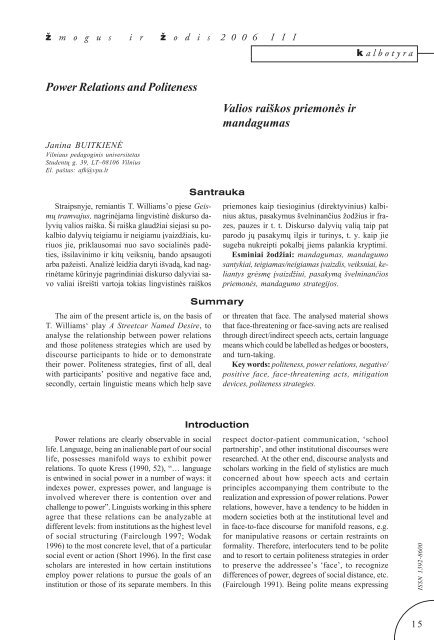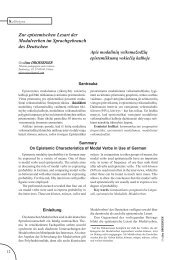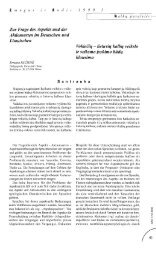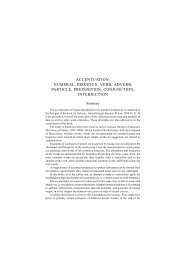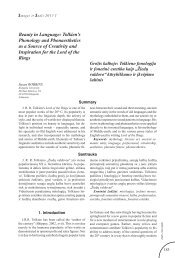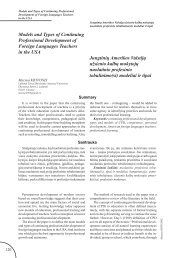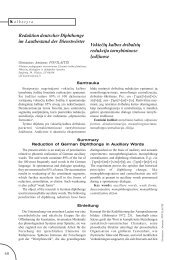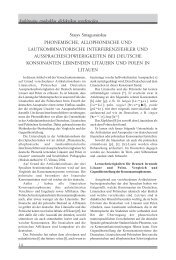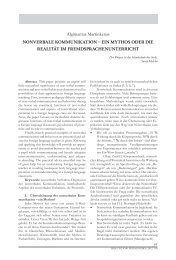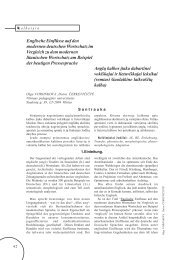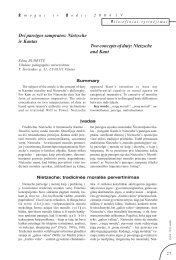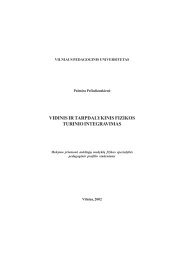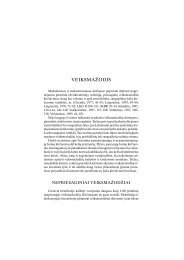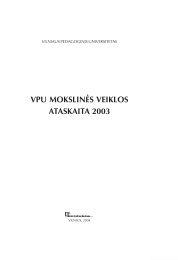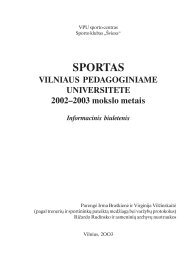Full Text - VPU biblioteka - Vilniaus pedagoginis universitetas
Full Text - VPU biblioteka - Vilniaus pedagoginis universitetas
Full Text - VPU biblioteka - Vilniaus pedagoginis universitetas
You also want an ePaper? Increase the reach of your titles
YUMPU automatically turns print PDFs into web optimized ePapers that Google loves.
þ m o g u s i r þ o d i s 2 0 0 6 I I I<br />
Power Relations and Politeness<br />
Janina BUITKIENË<br />
<strong>Vilniaus</strong> <strong>pedagoginis</strong> <strong>universitetas</strong><br />
Studentø g. 39, LT–08106 Vilnius<br />
El. paðtas: afk@vpu.lt<br />
Straipsnyje, remiantis T. Williams’o pjese Geismø<br />
tramvajus, nagrinëjama lingvistinë diskurso dalyviø<br />
valios raiðka. Ði raiðka glaudþiai siejasi su pokalbio<br />
dalyviø teigiamu ir neigiamu ávaizdþiais, kuriuos<br />
jie, priklausomai nuo savo socialinës padëties,<br />
iðsilavinimo ir kitø veiksniø, bando apsaugoti<br />
arba paþeisti. Analizë leidþia daryti iðvadà, kad nagrinëtame<br />
kûrinyje pagrindiniai diskurso dalyviai savo<br />
valiai iðreiðti vartoja tokias lingvistinës raiðkos<br />
The aim of the present article is, on the basis of<br />
T. Williams‘ play A Streetcar Named Desire, to<br />
analyse the relationship between power relations<br />
and those politeness strategies which are used by<br />
discourse participants to hide or to demonstrate<br />
their power. Politeness strategies, first of all, deal<br />
with participants’ positive and negative face and,<br />
secondly, certain linguistic means which help save<br />
Power relations are clearly observable in social<br />
life. Language, being an inalienable part of our social<br />
life, possesses manifold ways to exhibit power<br />
relations. To quote Kress (1990, 52), “… language<br />
is entwined in social power in a number of ways: it<br />
indexes power, expresses power, and language is<br />
involved wherever there is contention over and<br />
challenge to power”. Linguists working in this sphere<br />
agree that these relations can be analyzable at<br />
different levels: from institutions as the highest level<br />
of social structuring (Fairclough 1997; Wodak<br />
1996) to the most concrete level, that of a particular<br />
social event or action (Short 1996). In the first case<br />
scholars are interested in how certain institutions<br />
employ power relations to pursue the goals of an<br />
institution or those of its separate members. In this<br />
Santrauka<br />
Summary<br />
Introduction<br />
Valios raiðkos priemonës ir<br />
mandagumas<br />
k albotyra<br />
priemones kaip tiesioginius (direktyvinius) kalbinius<br />
aktus, pasakymus ðvelninanèius þodþius ir frazes,<br />
pauzes ir t. t. Diskurso dalyviø valià taip pat<br />
parodo jø pasakymø ilgis ir turinys, t. y. kaip jie<br />
sugeba nukreipti pokalbá jiems palankia kryptimi.<br />
Esminiai þodþiai: mandagumas, mandagumo<br />
santykiai, teigiamas/neigiamas ávaizdis, veiksniai, keliantys<br />
grësmæ ávaizdþiui, pasakymà ðvelninanèios<br />
priemonës, mandagumo strategijos.<br />
or threaten that face. The analysed material shows<br />
that face-threatening or face-saving acts are realised<br />
through direct/indirect speech acts, certain language<br />
means which could be labelled as hedges or boosters,<br />
and turn-taking.<br />
Key words: politeness, power relations, negative/<br />
positive face, face-threatening acts, mitigation<br />
devices, politeness strategies.<br />
respect doctor-patient communication, ‘school<br />
partnership’, and other institutional discourses were<br />
researched. At the other end, discourse analysts and<br />
scholars working in the field of stylistics are much<br />
concerned about how speech acts and certain<br />
principles accompanying them contribute to the<br />
realization and expression of power relations. Power<br />
relations, however, have a tendency to be hidden in<br />
modern societies both at the institutional level and<br />
in face-to-face discourse for manifold reasons, e.g.<br />
for manipulative reasons or certain restraints on<br />
formality. Therefore, interlocuters tend to be polite<br />
and to resort to certain politeness strategies in order<br />
to preserve the addressee’s ‘face’, to recognize<br />
differences of power, degrees of social distance, etc.<br />
(Fairclough 1991). Being polite means expressing<br />
ISSN 1392-8600<br />
15
16<br />
Power Relations and Politeness<br />
respect towards the person you are talking to and<br />
avoiding offending him/her. In many works<br />
‘politeness’ is used to refer to behaviour which<br />
actively expresses positive concern for others as well<br />
as non-imposing distancing behaviour. The<br />
The research was conducted on the basis of<br />
drama dialogue, as it most closely resembles<br />
spontaneous conversation in which speech acts and<br />
politeness principles function most naturally.<br />
Following Short (1996), it should be noted that<br />
discourse structure of drama possesses features both<br />
similar to and different from casual conversation.<br />
The scholar claims that drama dialogue differs from<br />
conversation mainly in 1) it is written to be spoken<br />
while conversation is unprepared and unrehearsed<br />
and 2) normal non-fluency does not occur in drama<br />
dialogue: if these features do appear, they serve some<br />
other meaningful purposes as intended by the<br />
dramatist. In ordinary conversation these normal<br />
non-fluency features are usually not noticed. On<br />
the other hand, both drama dialogue and casual<br />
Materials and methods<br />
Valios raiðkos priemonës ir mandagumas<br />
linguistic means by which politeness is expressed in<br />
languages are varied. In this paper an attempt is<br />
made to briefly analyse the correlation between<br />
power relations and politeness strategies employed<br />
in T. Williams’ play A Streetcar Named Desire.<br />
conversation share certain similarities such as turntaking<br />
patterns; characters or persons perform<br />
certain speech acts; their utterances are situation<br />
dependent; they may say one thing but mean<br />
something else, etc. (Short op. cit., 174-181). The<br />
above mentioned commonalities give plausible<br />
grounds to treat drama dialogue as being rather close<br />
to casual conversation.<br />
The paper analyses the above mentioned issues<br />
applying the method of linguistic research which<br />
has become known as critical linguistics (Kress<br />
1990; Fairclough 1991, 1997) and which is<br />
essentially concerned with discourse as a social<br />
phenomenon, social interaction involving displays<br />
of power.<br />
Theoretical prerequisites of the study<br />
Power relations are an all-embracing<br />
phenomenon of social life. The current tendencies<br />
in our present-day societal life presuppose the<br />
avoidance of explicit expression of institutional or<br />
personal power; thus, at both levels those in power<br />
are supposed to resort to certain measures which in<br />
a way tend to hide power relations. Preference to<br />
indirect speech acts, observing the cooperative<br />
principle and already established politeness<br />
strategies can work in the opposite ways: either to<br />
‘hide’ power relations (if it is unavoidable, at least<br />
to reveal them in the most socially acceptable way)<br />
or to expose them. This is the point at which power<br />
relations and politeness meet or overlap, and<br />
generations of linguists tried to explain and give<br />
reasons for such behaviour of ours.<br />
First of all, politeness is closely connected with<br />
speech act theory. Pertinent to the study of politeness<br />
is the fact of dividing speech acts into direct and<br />
indirect. It became generally acknowledged that<br />
politeness is more associated with indirectness;<br />
directives are more often expressed as interrogatives<br />
or affirmatives than imperatives. Thus indirect<br />
speech acts are one of many forms of politeness<br />
frequently used in situations which lack familiarity,<br />
exhibit the formality of the context and social<br />
distance (differences of status, role, age, gender,<br />
education, class, occupation, and ethnicity) (Cutting<br />
2003).<br />
Another discourse framework which is capable<br />
of revealing the nature of social relationships<br />
between individuals was developed by P. Brown and<br />
S. Levinson who laid foundations for the principles<br />
of politeness. Central to the notion of politeness<br />
phenomenon is the concept of face. Face is seen as<br />
a kind of public ‘self-image’ which members of a<br />
society claim for themselves. It consists of two<br />
related aspects: positive and negative face.<br />
According to Brown & Levinson (2000, 322),<br />
negative face “is the want of every ‘competent adult<br />
member’ that his actions be unimpeded by others”,<br />
while positive face “is the want of every member<br />
that his wants be desirable to at least some others”.<br />
In other words, negative face refers to any person’s<br />
basic claims to territories, personal preserves and<br />
the right to non-distraction, i.e. the need to be<br />
independent. Positive face, on the other hand, refers<br />
to any person’s need to be accepted, even liked, by<br />
others, to be treated as a member of the same group,<br />
and to know that his/her wants are shared by others,<br />
i.e. the need to be connected. However, speakers<br />
often perform acts which ‘threaten’ the addressee’s<br />
face. These acts are called face-threatening acts<br />
(FTA). According to the above mentioned scholars,<br />
Janina BUITKIENË
þ m o g u s i r þ o d i s 2 0 0 6 I I I<br />
there are various ways of performing FTAs which<br />
depend upon the social (power) relationship of the<br />
interlocutors, the context of interaction and the<br />
amount of imposition. As a result, the addresser,<br />
while performing a FTA, may select one from a<br />
number of strategies. He may choose a direct, though<br />
impolite, form (e.g. Open the window!) which is<br />
named by the scholars ‘baldly, without redress’.<br />
Performing such an act, the speaker shows little<br />
concern for the hearer’s face. Very often such bald<br />
non-redressive speech acts occur where the speaker<br />
holds relatively high power. Another solution is to<br />
perform a FTA using an indirect strategy, which is<br />
called off-record (e.g. It’s a bit stuffy in here. – an<br />
indirect request to open the window). By choosing<br />
to go off record, the speaker uses the form of a<br />
declarative sentence, thus appearing to be noncoercive<br />
and avoiding the responsibility of damaging<br />
the addressee’s face. As noted by Brown & Levinson<br />
(op. cit., 327), Cutting (2003, 48) and other<br />
pragmatists, linguistic realization of off-record<br />
strategies include metaphor, irony, rhetorical<br />
questions, understatement, tautologies and all kinds<br />
of indirect hints. A milder FTA will be when the<br />
speaker goes on record. By going on record, he may<br />
choose to perform the FTA baldly, without redress<br />
(mentioned earlier) or to perform a FTA with<br />
redressive action, e.g. Would you mind opening the<br />
window, I wonder if you could open the window, etc.<br />
Most frequently, however, speakers do FTAs on<br />
record taking account of face. Thus they do this on<br />
record with redressive action, using negative<br />
politeness and positive politeness. These two types<br />
of politeness are realized through different strategies<br />
and depend strongly on certain social dimensions<br />
such as the solidarity-social distance dimension, the<br />
power dimension, and the formality dimension<br />
(Holmes 1999, 11).<br />
Some of these politeness strategies are rather<br />
transparent in terms of their classification and<br />
inventory; however, others, such as hedges, present<br />
a more confusing picture as far as their classification<br />
and labelling are concerned. Hedging is considered<br />
to be one of the most important politeness strategies,<br />
and hedges are described as a means of toning-down<br />
utterances and statements in order to reduce the<br />
riskiness of what one says, to mitigate what may<br />
otherwise seem too forceful, to express politeness<br />
or respect to strangers and superiors. Scholars,<br />
working in this field, completely agree upon this<br />
crucial function of hedges; however, their inventory<br />
is far from clear. Following Markkanen & Schröder<br />
(2006, 4), it could be stated that “no clear-cut lists<br />
k albotyra<br />
of hedging expressions are possible” because “no<br />
linguistic items are inherently hedgy but can acquire<br />
this quality depending on the communicative<br />
context or the co-text”. Roughly speaking, linguists<br />
attribute the quality of hedging to such word-groups<br />
and expressions as modals (e.g. may, might, could,<br />
etc.), modal adjuncts (e.g. possibly, perhaps, probably,<br />
etc.), modal nouns (e.g. possibility), lexical verbs<br />
highlighting doubt (e.g. suggest), ‘approximators’<br />
(e.g. roughly, sort of, quite, etc.), that clauses (often<br />
in combination with modals) (e.g. it could be the<br />
case that…, it appears that…). Holmes (1999)<br />
attributes to hedges vocal hesitations (um, er) and<br />
such linguistic forms as you know, I think, sort of<br />
which she labels as pragmatic particles. In her<br />
opinion, tag questions also function as hedges. Hoye<br />
analysed modals and their adverb satellites (they<br />
are called modal-adverb expressions) such as could<br />
kindly, will kindly, could possibly on three levels –<br />
syntactic, semantic and pragmatic. At a pragmatic<br />
level, the scholar claims, “their role of protecting<br />
face in negative politeness strategies in particular,<br />
is crucial” (Hoye 1997, 133).<br />
Hedges are considered to be negative politeness<br />
strategies. However, there is no one-to-one<br />
relationship between a linguistic form and its<br />
realization; one form may serve many functions,<br />
and particular functions are expressed by a variety<br />
of forms. Functioning of the above mentioned<br />
linguistic items as hedges or boosters, as a means of<br />
expressing positive or negative politeness depends<br />
heavily upon the context.<br />
In the discussion of power relations and<br />
politeness, a mention should be made of turn-taking.<br />
Turn-taking in general is the major concern of the<br />
Conversation Analysis (CA) approach to spoken<br />
discourse, which investigates the principles of the<br />
organization of taking turns. The essence of this<br />
approach is to analyse ‘pure’ versions of discourse,<br />
without appealing to any evidence that comes from<br />
outside the talk itself. The pioneers in this field, H.<br />
Sacks, E. Schegloff and G. Jefferson, defined the<br />
structure of the conversation and the mechanism of<br />
turn-taking. Later, CA was supplemented by<br />
ethnomethodological approach which implies<br />
investigation of concrete actions of people going<br />
about their everyday business. Thus spoken<br />
discourse, or turn-taking, became viewed as a means<br />
to express gender, ethnical, age, etc. differences, to<br />
establish dominance (power) and self-identity. In<br />
any case, it is evident that turn-taking can be<br />
considered as one of mitigating or face threatening<br />
devices in the analysis of power relation and<br />
ISSN 1392-8600<br />
17
18<br />
Power Relations and Politeness<br />
consideration of speaker’s/hearer’s face wants. Such<br />
qualities of turn-taking as defining the content of<br />
conversation and its direction, the number of moves<br />
The analysis was based on the relationships<br />
between two characters of the play – Stanley and<br />
Blanche, and a couple of significant encounters<br />
between them were taken into consideration.<br />
Their first encounter takes place as soon as<br />
Blanche arrives at her sister’s place, and it is<br />
Blanche’s and Stanley’s first meeting. Their<br />
relationship during this meeting seems to be<br />
symmetrical in terms of power relations, those of a<br />
polite host and his visitor, his wife’s sister. As soon<br />
as they see each other, Blanche establishes his<br />
identity using a booster must (You must be Stanley)<br />
and introduces herself. The assumed symmetry on<br />
Stanley’s part is maintained throughout their first<br />
encounter, first of all, by his constantly addressing<br />
Blanche by her first name. This way Stanley employs<br />
one of many solidarity strategies. Another instance<br />
when Stanley tries to save his and Blanche’s negative<br />
face during this encounter is when he wants to take<br />
off his shirt – he resorts to on record redressive<br />
action, e.g. Do you mind if I make myself<br />
comfortable?, thus minimizing his imposition and<br />
showing deference to Blanche. In addition, during<br />
their first meeting it is Stanley who uses tag questions,<br />
e.g. You’re a teacher, aren’t you?, You were married<br />
once, weren’t you? Tag questions are considered as<br />
one of mitigating devices mostly employed by<br />
women (Tannen, 2003). One of the possible<br />
explanations why Stanley uses this kind of mitigation<br />
strategy could be the factor that in this first face-toface<br />
encounter with Blanche Stanley attempts to<br />
hide his power and to maintain his own and Blanche’s<br />
face. A hedge I’m afraid in I’m afraid I’ll strike you<br />
as being the unrefined type also serves the same<br />
purpose.<br />
However, as claimed by Holmes (2000, 80), tag<br />
questions can fulfil four distinct functions:<br />
epistemic modal, challenging, facilitative, and<br />
softening. Out of these, only facilitative and softening<br />
tags serve as positive/negative politeness strategies.<br />
Tags used as epistemic modals express the speaker’s<br />
uncertainty rather than politeness while challenging<br />
tags are more impoliteness devices. In the given<br />
situation, i.e. in case of written discourse, turns are<br />
devoid of prosodic features, and their absence makes<br />
it difficult to differentiate among the above<br />
mentioned functions. It is hardly believable that<br />
Valios raiðkos priemonës ir mandagumas<br />
Results and discussions<br />
and their length, the use (or not use) of mitigation<br />
in the moves – all these are strategies for expressing<br />
power relations and politeness.<br />
Stanley could have used challenging tags during their<br />
first meeting; it is quite possible that he is uncertain<br />
about some facts and wants to elicit additional<br />
information. Thus he might use tags as epistemic<br />
modals rather than politeness strategies.<br />
Yet, his dominance is clearly felt in their<br />
discourse, and this feeling is supported by turntaking:<br />
his turns are longer, he shows the initiative<br />
and thus controls the content and direction of the<br />
conversation. To get the necessary information, he<br />
uses on record without redress actions which find<br />
their expression in the form of questions having the<br />
force of command, e.g. Stella’s sister?, You going to<br />
shack up here? etc. Most of Blanche’s turns are short,<br />
heavily mitigated and contain hedges of various<br />
sorts. She uses unfinished sentences, e.g. I –uh-;<br />
elliptical sentences, e.g. Stella’s sister? – Yes., What<br />
do you teach, Blanche? – English. etc.; hesitation<br />
pauses which are the major mitigating devise in her<br />
discourse, e.g. Why, I – live in Laurel., I – don’t know<br />
yet., The boy – the boy died.; modal adjuncts, e.g.<br />
No, I – rarely touch it., and other mitigating phrases,<br />
e.g. I’m afraid I’m – going to be sick!<br />
Turn-taking plays a crucial role in defining the<br />
relationship between Blanche and Stanley. Though<br />
the latter uses quite a few politeness strategies (both<br />
positive and negative) as well as certain mitigation<br />
devices, turn-taking demonstrates Stanley’s power.<br />
Blanche only feebly and hesitantly reacts to Stanley’s<br />
questions and comments, especially if we take into<br />
consideration the preceding interaction between her<br />
and her sister; she controlled their conversation, its<br />
content and direction, and her turns were long.<br />
Their second encounter takes place after Stanley<br />
finds out about the loss of Belle Reve, the piece of<br />
property, which belonged to both sisters. This piece<br />
of news irritates and antagonises Stanley while<br />
Blanche feels less unnerved and more of herself.<br />
The basic feature of this encounter is that Blanche’s<br />
turns vary from those of polite and face-saving to<br />
those of face-threatening; Stanley’s turns, on the<br />
other hand, contain mainly face-threatening acts<br />
performed baldly on record.<br />
At the beginning of this encounter Blanche<br />
attempts to control the length of the turns and their<br />
content – she speaks about how she feels, wants to<br />
be praised on her looks, even asks Stanley to button<br />
Janina BUITKIENË
þ m o g u s i r þ o d i s 2 0 0 6 I I I<br />
her dress at the back. She tries to be friendly and<br />
polite, first of all, by greeting him and addressing<br />
him by his first name, e.g. Hello, Stanley! which<br />
fulfills phatic function and, according to Malinowski<br />
(2000 304), “serves to establish bonds of personal<br />
union between people brought together by the mere<br />
need of companionship…”. Goffman (2000, 318)<br />
also claims that greetings as well as farewells put<br />
people in certain social relationships the<br />
characteristic obligation of which is “that each of<br />
the members guarantees to support a given face for<br />
the other members in given situations”. Thus<br />
Blanche resorts to positive and negative politeness<br />
strategies, the others being apology, e.g. Excuse me<br />
while I slip on my pretty new dress!, I’m sorry,<br />
expressions of gratitude, e.g. Many thanks!, Why,<br />
thanks!; she tries to include Stanley into a joint<br />
activity performing a face-threatening act with<br />
redressive action, e.g. I’m going to ask a favor of you<br />
in a moment. It is interesting to note that during the<br />
first half of their encounter Blanche more often<br />
addresses Stanley by name than he does; thus she<br />
resorts to a positive politeness strategy,<br />
demonstrating closeness and appealing to<br />
friendship. With the growth of tension, she passes<br />
onto his family name Mr. Kowalsky. On the one hand,<br />
the use of formal address forms could be considered<br />
a negative politeness strategy aiming to save the<br />
interlocutor’s face; on the other hand, taking into<br />
consideration the context of the situation, it is<br />
possible to claim that Blanche here performs a facethreatening<br />
act which is done baldly, without redress.<br />
The change in her attitude towards their relationship<br />
is reinforced by a comparison as well, e.g. What’s in<br />
the back of that little boy’s mind of yours?<br />
Blanche uses hedges such as modals, e.g. May I<br />
have a drag on your cig?, I cannot imagine any witch<br />
of a woman casting a spell over you., That must’ve<br />
been what happened.; lexical verbs highlighting<br />
doubt, e.g. It looks like my trunk has exploded.,<br />
pragmatic particles, e.g. Well, life is too full of evasions<br />
and ambiguities, I think. You are simple,<br />
straightforward and honest, a little bit on the primitive<br />
side, I should think. In the latter turn Blanche uses<br />
bald on record face-threatening act to describe<br />
Stanley’s character; in order to mitigate her<br />
The analysis of the relationship between power<br />
relations and politeness strategies in T. Williams’<br />
play A Streetcar Named Desire proves that power<br />
relations and politeness are closely interrelated.<br />
Conclusions<br />
k albotyra<br />
statement she employs double-hedging in her<br />
statement – the pragmatic particle combined with<br />
the modal I should think and the approximator a<br />
little bit thus aiming to save Stanley’s negative face.<br />
All in all, Blanche employs most of positive and<br />
negative politeness strategies during the first part of<br />
the encounter before their conversation reaches its<br />
highest point. Later she performs quite a lot of bold<br />
non-redressive face-threatening acts thus showing<br />
little concern for the hearer’s face, e.g. Give those<br />
back to me!, The touch of your hands insults them!,<br />
Just give them back to me!, etc.<br />
Stanley’s turns are short and matter-of-fact at the<br />
beginning, e.g. Have one for yourself, That’s right,<br />
That’s good, etc. He makes no attempts to be either<br />
polite or impolite. The hedge looks like in It looks<br />
like you raided some stylish shops in Paris bears more<br />
face-threatening than face-saving meaning.<br />
However, his later turns mainly contain bold on<br />
record face-threatening acts which are linguistically<br />
expressed as imperatives and questions, e.g. Don’t<br />
play so dumb., Where’s the papers? In the trunk?,<br />
What in hell are they?, I don’t want no ifs, ands or<br />
buts! etc. These face-threatening acts overtly show<br />
Stanley’s power and dominance in this situation. In<br />
addition, these acts are reinforced by his body<br />
language, i.e. he seizes the atomizer and slams it<br />
down, opens her trunk in search of papers, etc. Only<br />
at the end of the encounter, having perceived Stella’s<br />
sorrow and distress and as if trying to apologize, he<br />
mitigates his statement by the pragmatic particle<br />
you see, e.g. You see, under the Napoleonic code – a<br />
man has to take interest in his wife’s affairs –<br />
especially now that she’s going to have a baby.<br />
The turn-taking in this episode is different from<br />
the previous one. Both discourse participants<br />
demonstrate efforts to control the content and<br />
direction of the conversation, and both of them take<br />
long and short turns. Though Stanley mainly resorts<br />
to bald on record face-threatening acts thus<br />
exhibiting his power over Stella, the latter, unlike<br />
during their first encounter, tries to dominate the<br />
situation by using positive politeness strategies and<br />
bald on record face threatening acts as well as<br />
boosters.<br />
Positively polite behaviour expresses friendliness;<br />
negatively polite behaviour expresses respect.<br />
Respect most clearly is expressed to those who are<br />
complete strangers or who are in a higher social or<br />
ISSN 1392-8600<br />
19
20<br />
Power Relations and Politeness<br />
professional position, i.e. they have power. Those<br />
who are in a lower social position and have less<br />
power tend to rely heavily on negative politeness<br />
strategies to express the deference. Those who<br />
possess power can go to extremes while<br />
communicating with their less powerful partners;<br />
they can either hide their power by also resorting to<br />
negative politeness strategies or show it openly by<br />
using bald on record non-redressive acts.<br />
Turn-taking and hedging play a crucial role in<br />
expressing power relations and positive/negative<br />
Brown P., Levinson S. C., 2000. Politeness: Some<br />
Universals in Language Usage. In: The Discourse<br />
Reader ed. by A. Jaworsky and N. Coupland. -<br />
London & New York: Routledge.<br />
Cutting J., 2003. Pragmatics and Discourse. - London &<br />
New York: Routledge.<br />
Fairclough N., 1991. Language and Power. - London &<br />
New York: Longman.<br />
Fairclough N., 1997. Critical Discourse Analysis. - London<br />
& New York: Longman.<br />
Goffman E., 2000. On Face-work: An Analysis of Ritual<br />
Elements in Social Interaction. In: The Discourse<br />
Reader ed. by A. Jaworsky and N. Coupland.-<br />
London & New York: Routledge.<br />
Holmes J., 1999. Women, Men and Politeness. - Longman<br />
Group UK Limited.<br />
Holmes J., 2000. Women, Men and Politeness:<br />
Agreeable and Disagreeable Responses. In: The<br />
Discourse Reader ed. by A. Jaworski and<br />
N. Coupland. - London & New York: Routledge.<br />
References<br />
Valios raiðkos priemonës ir mandagumas<br />
politeness. A more powerful speaker usually<br />
possesses greater opportunities to control the length<br />
of the turns, their content and direction.<br />
Hedging is a powerful instrument in expressing<br />
negative politeness; on the other hand, some hedges<br />
serve as strategies for showing positive politeness.<br />
It should be mentioned, however, that so far there<br />
does not exist a detailed inventory of hedging devices<br />
and there is no unanimous agreement how to label<br />
one or another language item which serves as a hedge<br />
in a concrete situation.<br />
Hoye L., 1997. Adverbs and Modality in English. -<br />
London & New York: Longman.<br />
Kress G., 1990. Linguistic Processes in Sociocultural<br />
Practice. - Hong Kong: OUP.<br />
Markkanen R. & Schröder H. Hedging: A Challenge for<br />
Pragmatics and Discourse Analysis. http://<br />
www.sw2.euv-frankfurt-o.de/Publikationen/<br />
hedging/markkane/markkane.html accessed<br />
20006 02 02<br />
Malinowski B., 2000. On Phatic Communication. In:<br />
The Discourse Reader ed. by A. Jaworski and N.<br />
Coupland. - London & New York: Routledge.<br />
Short M., 1996. Exploring the Language of Poems, Plays<br />
and Prose. - Longman/ Pearson.<br />
Tannen D., 2003. Women and Indirectness. In:<br />
J. Cutting Pragmatics and Discourse. - London &<br />
New York: Routledge.<br />
Wodak R., 1996. Disorders of Discourse. - London &<br />
New York: Longman.<br />
Janina BUITKIENË


